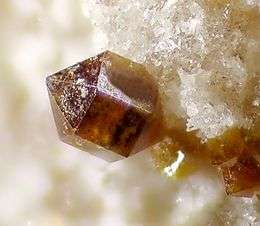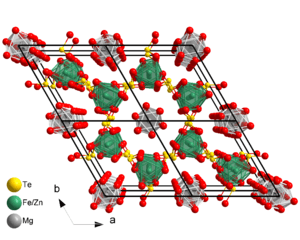Zemannite
Zemannite is a very rare oxide mineral with the chemical formula Mg0.5ZnFe3+[TeO3]3·4.5H2O. It crystallizes in the hexagonal crystal system and forms small prismatic brown crystals. Because of the rarity and small crystal size, zemannite has no applications and serves as a collector's item.
| Zemannite | |
|---|---|
 | |
| General | |
| Category | Oxide mineral |
| Formula (repeating unit) | Mg0.5ZnFe3+[TeO3]3·4.5H2O |
| Strunz classification | 4.JM.05 |
| Crystal system | Hexagonal |
| Crystal class | Dipyramidal (6/m) H-M symbol: (6/m) |
| Space group | P63/m |
| Identification | |
| Formula mass | 741.25 g/mol |
| Color | Brown |
| Crystal habit | Hexagonal, prismatic |
| Cleavage | None |
| Luster | Vitreous – adamantine |
| Streak | White |
| Diaphaneity | Subtransparent |
| Specific gravity | 4.36[1] |
| Optical properties | Uniaxial |
| Refractive index | nω = 1.85; nε = 1.93 |
| Birefringence | δ = 0.08 |
| Other characteristics | Not radioactive, not fluorescent |
| References | [1][2][3] |
History and etymology
Zemannite was discovered in 1961 in a tellurium deposit near Moctezuma, Sonora, Mexico as an unnamed new mineral. It was not accepted then by the International Mineralogical Association (IMA) due to the uncertainty in its chemical composition.[1][4]
The mineral structure was solved in 1967 by Eckhart Matzat as (Na,H)2(Zn,Fe)3+(Mn,Mg)2[TeO3]3·nH2O is specified.[5] Two years later, the mineral was recognized by the IMA under the name zemannite, in honor of the Austrian mineralogist Josef Zemann (born 1923), who had worked extensively on tellurium minerals.[1][6]
Later investigations showed that zemannite, as well as the related mineral kinichilit, often contains impurities of sodium and magnesium and thus the formula was refined to its current form, Mg0.5ZnFe3+[TeO3]3·4.5H2O.[7]
Related minerals
Zemannite is a secondary mineral produced by weathering of native tellurium minerals, such as sylvanite or calaverite. As a result of this process, the elemental tellurium or tellurium-anions (Te2− or Te22−) transform into the Te4+ cation bound with oxygen into the tellurate ion [TeO3]2−.
Zemannite is chemically and structurally similar to keystoneite and kinichilite; together, these minerals form the so-called "zemannite group".[8]
In addition to Moctezuma, zemannite was also found in Vielsalm – a municipality in the Belgian province of Luxembourg and near Shimoda, Shizuoka, Japan.[3][9]
Morphology and structure

Zemannite crystallizes in the hexagonal crystal system, space group P63m with the lattice parameters a = 941 pm and c = 764 pm and two formula units per unit cell. The Te4+ bind with three oxygen atoms forming [TeO3]2− anions, where oxygens form trigonal pyramids around the tellurium ion. The Zn2+ and Fe3+ cations share the same cite with typical respective probabilities of 40% and 60%; those values can vary from crystal to crystal. The Mn2+ impurity, if present, also shares the same site. This site is surrounded by a distorted octahedron of six oxygen atoms. These tellurium-oxygen and Fe/Zn-oxygen polyhedra form a network with wide (0.83 nm diameter) channels parallel to the crystallographic c axis (normal to the picture). Therefore, zemannites are often attributed to zeolite materials. The channels are often occupied by sodium impurity and water.[1][6]
The Mg2+ cations form octahedral Mg[(H2O)6]2+ complexes with six water molecules which are located in the channels of the crystal structure. The occupancy of the Mg sites is 50% which is reflected by the coefficient 0.5 in the chemical formula.[7]
Zemannite forms prismatic crystals, usually smaller than 1 mm. Because zemannite is secondary mineral, its crystals usually on other rocks and retain the hexagonal shape corresponding to their crystal symmetry. The ideal pyramidal tips, as in the infobox image, are often absent.[1]
References
- JA Mandarino, E. Matzat, SJ Wiliams: Zemannite, a zinc tellurite from Moctezuma, Sonora, Mexico Canadian Mineralogist. Vol. 14, 1976, pp. 387-390.
- Zemannite at Webmineral
- Zemannite at Mindat
- Mandarino, J. A.; Williams, S. J.; Eto, M (1961). "Five new minerals from Moctezuma, Sonora, Mexico". Science. 133 (3469): 2017–8. Bibcode:1961Sci...133.2017M. doi:10.1126/science.133.3469.2017. PMID 13717370.
- E. Matzat: Die Kristallstruktur eines unbenannten zeolithartigen Tellurminerals, (Zn,Fe)2[TeO3]3}NaxH2−x • n H2O. In: Tschermaks Mineralogische und Petrologische Mitteilungen. Nr. XII, 1967, S. 108–117.
- E. Matzat, SJ Wiliams Zemannite, a new tellurite mineral from Moctezuma, Sonora, Mexico, Canadian Mineralogist Vol. 10, 1969, pp. 139–140.
- Miletich F (1995). "Crystal chemistry of the microporous tellurite minerals zemannite and kinichilite, Mg0.5(MeFe(TeO3)33)4.5H2O, (Me=Zn; Mn)". European Journal of Mineralogy. 7 (3): 509–523. doi:10.1127/ejm/7/3/0509.
- Zemannite Group
- H. Hori; E. Koyama; K. Nagashima (1980). "Kinchilite, a new mineral from the Kawazu mine, Shimoda city, Japan". Mineralogical Journal. 10 (7): 333. Bibcode:1981MinJ...10..333H. doi:10.2465/minerj.10.333.
Further reading
- RV Gaines:The Moctezuma tellurium Deposit. In:Mineralogical Record. No. 1, 1970, pp. 40–43.
- S. White:The big Lapis minerals directory. 4th Edition. Christian Weise Verlag, Munich 2002, ISBN 3-921656-17-6